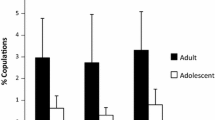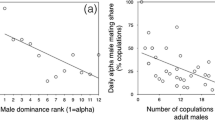Abstract
Chimpanzees have complex and variable mating strategies, but most copulations occur when females with full sexual swellings are in parties with multiple males and mate with most or all of those males. Daily copulation rates for fully swollen females vary at different times of a female’s cycle, among females, and across communities and populations. Variation in female age, parity, and cycle stage underlie some of this variation, but possible demographic effects on copulation rates have not been systematically investigated. Demographic variation can affect many aspects of behavior and ecology, including the frequency and success of different mating tactics. Analysis of data from the unusually large chimpanzee community at Ngogo produces two results that are consistent with the hypothesis that demographic variation affects female copulation rates. Copulation rates were high compared with those reported from other research sites, where females had fewer potential mates available. Daily copulation rates of fully swollen females were also positively related to the number of males with whom they associated. Ngogo data also re-confirm results from other studies, of both wild and captive populations, showing that female copulation rates increase during periovulatory periods. This is consistent with the hypothesis that sexual swellings and extended receptivity and proceptivity help to protect females against infanticide by helping to ensure they mate with all potential sires. As at some other sites, parous females at Ngogo copulated at higher rates than nulliparous females. Possible effects of demography on sexual behavior should be considered in assessments of differences between chimpanzees and bonobos and of variation across chimpanzee populations.


Similar content being viewed by others
References
Altmann SA, Altmann J (1979) Demographic constraints on behavior and social organization. In: Bernstein I, Smith EO (eds) Primate ecology and human origins. Garland, New York, pp 47–64
Arcadi AC, Wrangham RW (1999) Infanticide in chimpanzees: review of cases and a new within-group observation from the Kanyawara study group in Kibale National Park. Primates 40:337–351
Boesch C (1996) Social grouping in Taï chimpanzees. In: McGrew WC, Nishida T, Marchant LF (eds) Great ape societies. Cambridge University Press, Cambridge, pp 101–113
Boesch C, Boesch-Achermann H (2000) The chimpanzees of the Taï Forest. Oxford University Press, Oxford
Butynski T (1990) Comparative ecology of blue monkeys (Cercopithecus mitis) in high- and low-density subpopulations. Ecol Monogr 60:1–60
Chapman C, Wrangham RW, Chapman L (1995) Ecological constraints on group size: an analysis of spider monkey and chimpanzee subgroups. Behav Ecol Sociobiol 36:59–70
Deschner T, Heistermann M, Hodges K, Boesch C (2003) Timing and probability of ovulation in relation to sex skin swelling in wild west African chimpanzees, Pan troglodytes verus. Anim Behav 66:551–560
Deschner T, Heistermann M, Hodges K, Boesch C (2004) Female swelling, timing of ovulation, and male behavior in wild west African chimpanzees. Horm Behav 46:204–215
Doran D (1997) Influence of seasonality on activity patterns, feeding behavior, ranging, and grouping patterns in Taï chimpanzees. Int J Primatol 18:183–206
Dunbar RIM (1988) Primate social systems. Cornell University Press, Ithaca
Emery Thompson M (2005) Reproductive endocrinology of wild female chimpanzees (Pan troglodytes schweinfurthii): methodological considerations and the role of hormones in sex and conception. Am J Primatol 67:137–158
Furuichi T, Hashimoto C (2002) Why female bonobos have a lower copulation rate during estrous than female chimpanzees. In: Boesch C, Hohmann G, Marchant L (eds) Behavioral diversity in chimpanzees and bonobos. Cambridge University Press, Cambridge, pp 156–167
Goodall J (1986) The chimpanzees of Gombe. Harvard University Press, Cambridge
Hasegawa T (1989) Sexual behavior of resident and immigrant female chimpanzees at Mahale. In: Heltne PG, Marquardt LA (eds) Understanding chimpanzees. Harvard University Press, Cambridge, pp 90–103
Hasegawa T, Hiraiwa-Hasegawa M (1983) Opportunistic and restrictive matings among wild chimpanzees in the Mahale mountains. J Ethol 1:75–85
Hasegawa T, Hiraiwa-Hasegawa M (1990) Sperm competition and mating behavior. In: Nishida T (ed) The chimpanzees of the Mahale Mountains. Tokyo University Press, Tokyo, pp 115–132
Hashimoto C, Furuichi T (2006) Frequent copulation by females and high promiscuity in chimpanzees in the Kalinzu Forest, Uganda. In: Newton-Fisher N, Notman H, Reynolds V, Paterson JD (eds) Primates of western Uganda. Springer, New York, pp 247–257
Hashimoto C, Furuichi T, Tashiro Y (2001) What factors influence the size of chimpanzee parties in the Kalinzu Forest, Uganda? Examination of fruit abundance and the number of estrous females. Int J Primatol 22:947–959
Kano T (1992) The last ape: pygmy chimpanzee behavior and ecology. Stanford University Press, Stanford
Kano T (1996) Male rank order and copulation rate in a unit-group of bonobos at Wamba, Zaire. In: McGrew WC, Marchant LF, Nishida T (eds) Great ape societies. Cambridge University Press, Cambridge, pp 135–145
Kano T (1998) Comments on Stanford, The social behavior of chimpanzees and bonobos. Curr Anth 39:410–411
Klinkova E, Hodges JK, Fuhrmann K, de Jong T, Heistermann M (2005) Male dominance rank, female mate choice and male mating and reproductive success in captive chimpanzees. Int J Primatol 26:357–384
Lwanga JS, Butynski TM, Struhsaker TT (2003) Tree population dynamics in Kibale National park, Uganda 1975–1998. Afr J Ecol 38:238–247
Matsumoto-Oda A (1999a) Mahale chimpanzees: grouping patterns and cycling females. Am J Primatol 47:197–207
Matsumoto-Oda A (1999b) Female choice in the opportunistic mating of wild chimpanzees (Pan troglodytes schweinfurthii) at Mahale. Behav Ecol Sociobiol 46:258–266
Mitani JC (2006) Demographic influences on the behavior of chimpanzees. Primates 47:6–13
Mitani JC, Amsler SJ (2003) Social and spatial aspects of male subgrouping in a community of wild chimpanzees. Behaviour 140:869–884
Mitani JC, Watts DP (1999) Demographic influences on the hunting behavior of chimpanzees. Am J Phys Anth 109:439–454
Mitani JC, Watts DP, Lwanga JS (2002) Ecological and social correlates of chimpanzee party size and gregariousness. In: Hohmann G, Boesch C (eds) Behavioral variation in chimpanzees and bonobos. Cambridge University Press, Cambridge, pp 102–111
Morin P (1993) Reproductive strategies in chimpanzees. Yrbk Phys Anth 36:179–212
Nunn CL (1999) The evolution of exaggerated sexual swellings in primates and the graded-signal hypothesis. Anim Behav 58:229–246
Parrish A (1994) Sex and food control in the “uncommon chimpanzee”: how bonobo females overcome a phylogenetic legacy of male dominance. Ethol Sociobiol 15:157–179
Reichert KE, Heistermann M, Hodges JK, Boesch C, Hohmann G (2002) What females tell males about their reproductive status: are morphological and behavioral cues reliable signals of ovulation in bonobos (Pan paniscus)? Ethol 108:583–600
Reynolds V (2005) The chimpanzees of the Budongo Forest. Oxford University Press, Oxford
Smuts BB, Smuts RW (1993) Male aggression and sexual coercion of females in nonhuman primates and other mammals: evidence and theoretical implication. In: Slater, PJB, Rosenblatt JS, Milinski M, Snowden, CT (eds) Advances in the study of behavior. Academic Press, New York, pp 22:1–63
Stanford CB (1998) The social behavior of chimpanzees and bonobos: empirical evidence and shifting assumptions. Curr Anth 39:399–420
Stanford CB, Wallis J, Mpongo E, Goodall J (1994) Hunting decisions in wild chimpanzees. Behavior 131:1–20
Struhsaker TT (1997) Ecology of an African rain forest. University Presses of Florida, Gainesvillle
Stumpf RM, Boesch C (2005) Does promiscuous mating preclude female choice? Female sexual strategies in chimpanzees of the Taï Forest, Cote d’Ivoire. Behav Ecol Sociobiol 57:511–524
Stumpf RM, Boesch C (2006) The efficacy of female choice in the chimpanzees of the Taï Forest, Cote d’Ivoire. Behav Ecol Sociobiol 60:749–765
Takahata Y, Ihobe H, Idani G (1996) Comparing copulations of chimpanzees and bonobos: do females exhibit proceptivity or receptivity? In: McGrew WC, Marchant LF, Nishida T (eds) Great ape societies. Cambridge University Press, Cambridge, pp 146–155
Takasaki (1985) Female life history and mating patterns among the M group chimpanzees of the Mahale Mountains National Park, Tanzania. Primates 26:121–129
Tutin CEG (1979) Mating patterns and reproductive strategies in a community of wild chimpanzees (Pan troglodytes schweinfurthii). Behav Ecol Sociobiol 6:29–38
Tutin CEG, McGinnis PR (1981) Chimpanzee reproduction in the wild. In: Graham CE (ed) Reproductive biology of the great apes. Academic Press, New York, pp 239–264
de Waal (1987) Tension regulation and nonreproductive functions of sex in captive bonobos (Pan paniscus). Nat Geo Res Rep 3:318–335
Wallis J (1992) Chimpanzee anogenital swelling and its role in the patterning of sociosexual behavior. Am J Primatol 28:101–113
Wallis J (1997) A survey of reproductive parameters in the free-ranging chimpanzees of Gombe National Park. J Repr Fert 109:297–307
Wallis J, Goodall J (1993) Anogenital swelling in pregnant chimpanzees in the Gombe National Park. Am J Primatol 31:89–98
Wallis J, Lemmon WB (1986) Social behavior and sexual swelling in pregnant chimpanzees (Pan troglodytes). Am J Primatol 10:171–183
Watts DP (1998) Coalitionary mate guarding by male chimpanzees at Ngogo, Kibale National Park, Uganda. Behav Ecol Sociobiol 44:43–55
Watts DP, Mitani JC (2002) Boundary patrols and intergroup encounters in wild chimpanzees. Behaviour 138:299–327
Wrangham RW (1993) The evolution of sexuality in chimpanzees and bonobos. Human Nature 4:47–79
Wrangham RW (2002) The cost of sexual attraction: is there a trade-off in female Pan between sex appeal and received coercion? In: Boesch C, Hohmann G, Marchant L (eds) Behavioral diversity in chimpanzees and bonobos. Cambridge University Press, Cambridge, pp 204–215
Acknowledgments
I thank the Uganda Wildlife Authority, The Ugandan Council for Science and Technology, and Makerere University for permission to do research at Ngogo. Dr Gilbert Isibirye Basuta and Dr John Kasenene have provided invaluable support for research efforts at Ngogo. My research on the chimpanzees there depends crucially on the collaboration of Dr Jeremiah Lwanga and the expert field assistance of Adolph Magoba, Godfrey Mbabazi, Lawrence Ndagezi, and Alfred Tumusiime. The L.S.B. Leakey Foundation, The National Geographic Society, Primate Conservation Inc., and Yale University have supported my fieldwork. Earlier versions of this manuscript benefitted greatly from constructive criticism by Takeshi Furuichi, Akiko Matsumoto-Oda, Melissa Emery Thompson, and one anonymous reviewer.
Author information
Authors and Affiliations
Corresponding author
About this article
Cite this article
Watts, D.P. Effects of male group size, parity, and cycle stage on female chimpanzee copulation rates at Ngogo, Kibale National Park, Uganda. Primates 48, 222–231 (2007). https://doi.org/10.1007/s10329-007-0037-2
Received:
Accepted:
Published:
Issue Date:
DOI: https://doi.org/10.1007/s10329-007-0037-2




